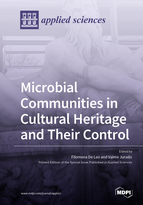Microbial Communities in Cultural Heritage and Their Control
A special issue of Applied Sciences (ISSN 2076-3417). This special issue belongs to the section "Applied Biosciences and Bioengineering".
Deadline for manuscript submissions: closed (15 October 2020) | Viewed by 41916
Special Issue Editors
Interests: biodeterioration of cultural heritage; applied microbiology; black fungi; molecular microbiology
Special Issues, Collections and Topics in MDPI journals
Interests: cultural heritage; environmental microbiology; molecular microbiology
Special Issues, Collections and Topics in MDPI journals
Special Issue Information
Dear Colleagues,
We are inviting manuscript submission for a Special Issue on “Microbial Communities in Cultural Heritage and Their Control”.
Cultural heritage plays a key role in understanding the history of humankind; therefore, adopting appropriate strategies for its conservation is essential. Microorganisms in particular environmental conditions cause serious problems in the conservation of cultural heritage, making the adoption of prevention and conservation strategies critical. Currently, most studies on microbial communities involved in the biodeterioration of cultural heritage rely on molecular identification and provide a list of species, in many cases without reference to their ecological characteristics or metabolic traits. For microbiologists involved in the protection of cultural heritage, this is particularly frustrating, because the identification of microorganisms is not sufficient to discern the origins and causes of a microbial attack, understand dispersion patterns, and prevent further undesired biodeterioration processes. Controlling microorganisms in cultural heritage is a major challenge for microbiologists. The search of appropriate methods to stop progressive microbial invasions without provoking secondary, and perhaps more dangerous, biological successions and biodeterioration is a necessity.
This Special Issue is aimed at publishing outstanding papers presenting cutting-edge advances in the field of cultural heritage and the control of its biodeterioration.
Dr. Filomena De Leo
Dr. Valme Jurado
Guest Editors
Manuscript Submission Information
Manuscripts should be submitted online at www.mdpi.com by registering and logging in to this website. Once you are registered, click here to go to the submission form. Manuscripts can be submitted until the deadline. All submissions that pass pre-check are peer-reviewed. Accepted papers will be published continuously in the journal (as soon as accepted) and will be listed together on the special issue website. Research articles, review articles as well as short communications are invited. For planned papers, a title and short abstract (about 100 words) can be sent to the Editorial Office for announcement on this website.
Submitted manuscripts should not have been published previously, nor be under consideration for publication elsewhere (except conference proceedings papers). All manuscripts are thoroughly refereed through a single-blind peer-review process. A guide for authors and other relevant information for submission of manuscripts is available on the Instructions for Authors page. Applied Sciences is an international peer-reviewed open access semimonthly journal published by MDPI.
Please visit the Instructions for Authors page before submitting a manuscript. The Article Processing Charge (APC) for publication in this open access journal is 2400 CHF (Swiss Francs). Submitted papers should be well formatted and use good English. Authors may use MDPI's English editing service prior to publication or during author revisions.
Keywords
- Cultural heritage
- Microbiology
- Biodeterioration
- Fungi
- Actinomycetes
- Biofilm
- Microbial communities
- Nanobiocides
- Control of biodeterioration
- Green chemistry
- Conservation







